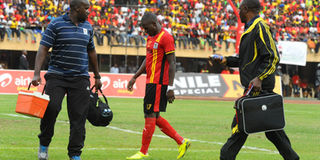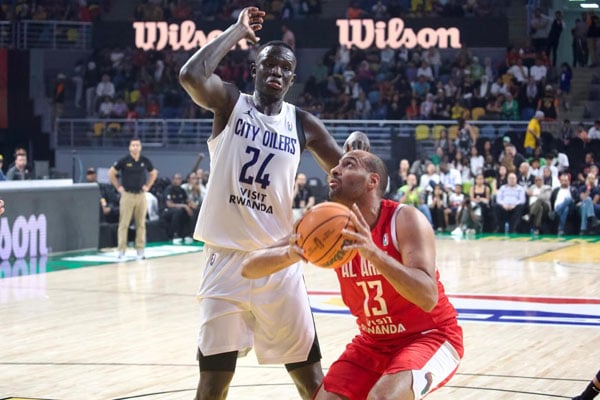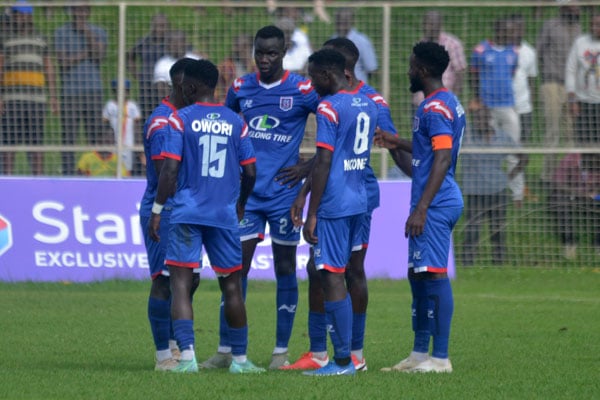Assessing medical preparedness in the Ugandan football structure

Qualified personel. KCCA and Cranes physiotherapist Ivan Ssewanyana (left) and national team doctor Ronald Kisolo (right) are two of the most qualified medics in Ugandan sport. PHOTO by Eddie Chicco
What you need to know:
- Soccer. March 19, last year, it was.
- Forty eight minutes into Express versus Proline Uganda Premier League match at Wankulukuku and Red Eagles defender Express defender Vincent Onyebuchi suffered a career ending injury.
- According to Ssewanyana, who also holds a certificate from Caf in Advanced Life Support, “bleeding must quickly be stopped and pain managed” when one suffers a fracture.
- Unfortunately, there was inadequate first aid for the Nigerian, with no equipped paramedics in the sight.
KAMPALA.
It is 14 years now since Marc-Vivien Foe passed on while on duty in a Confederations Cup semi-final game between Cameroon and Colombia at Lyon’s Stade de Gerland.
Medics were to later carry Foe, 28 at the time, off on a stretcher to the entrails of the stadium, where attempts to restart the player’s heart failed and ‘Marco’, as he was affectionately known by his team-mates, was pronounced dead.
A first autopsy failed to establish the cause of Foe’s death, but the second found he had been suffering from a condition called hypertrophic cardiomyopathy.
It is after Foe’s death that Fifa and its elite associations set out to work on huge improvements in the testing of footballers for heart problems ahead of tournaments, and the treatment they receive during matches.
Mandatory checkups
It is now mandatory for players to undergo pre-tournament medical checkups for Fifa, Caf and national competitions. Most Uganda Premier League (UPL) clubs had these checkups before the start of this season.
But with no insurance, the state of medical preparedness remains far off the pace you hope nothing tragic happens to the hundreds of players who go about their business hoping they get it done just fine. “There is still a lot to be done,” admitted KCCA physiotherapist Ivan Ssewanyana, whose club have three to four medics on average on match days.
But not every club can manage that. “Of course given the economy,” explained Ssewanyana, “Two people are good.”
KCCA medical staff includes a senior sports physiotherapist, who is Sewanyanna, an orthopedic surgeon and nutritionist among others.
On top of the team led by Ssewanyana, a typical match day at StarTimes Stadium, Lugogo, has some two nurses from the Health Ministry and KCCA (the Authority), plus an ambulance or two.
Life savers
The champions are also the only club to use a defibrillator, which they borrow from Fufa, at their home and continental matches. There are only two defibrillators in the country, which are kept at Fufa.
Fufa can only release these defibrillators to only qualified personnel, to which Ssewanyana, who – together with Dr. Ronald Kisolo - is also part of Uganda Cranes medical team, is.
The Ugandan FA secured the two life-saving defibrillators in 2014, then to be used during the 2015 Africa Cup of Nations (Afcon) qualifiers.
Defibrillators are used to deliver a curative dose of electrical energy to the heart, allowing normal sinus rhythm to be re-established by the body’s natural pacemaker after an attack.
The machines are similar to those used to save former Bolton Wanderers player Fabrice Muamba in 2012 when he suffered a cardiac arrest and collapsed during the first half of an FA Cup quarter-final match between Bolton and Tottenham Hotspur at White Hart Lane.
Ssewanyana averted a potential tragedy on the opening day of last season when a JMC player got concussed in KCCA’s 2-1 victory at Lugogo.
JMC had no qualified doctor or anyone equipped with the basic knowledge of what to do on their bench.
Both KCCA and JMC players sensed danger and beckoned the benches over for help. First, the bloke disguising as a medic on JMC bench rushed over to assess the situation. It hardly looked good.
Ssewanyana sprinted to the scene and immediately resuscitated the concussed player before travelling with him in a KCCA ambulance to nearby Naguru Hospital.
“They delayed to assess that the player needed urgent resuscitation,” explained Ssewanyana, a diploma holder in Sports Rehabilitation from the London Academy of Sports and Health Science.
“Players signaled. There was no pulse. From training, I realized that was a cardiac arrest. The personnel in the ambulance were also not ready for this. Worst scenario is that the boy could have died.
“The short trip to Naguru Hospital was a real battle as the boy battled for his life. You always anticipate the worst but pray for the best.” No defibrillator was on ground on the day.
One defibrillator goes for about Shs8.4m, and KCCA are looking to purchasing their own, according to Ssewanyana.
Onyebuchi misfortune
Fractures are some of the other graver injuries that have exposed the league as ill-prepared medically.
March 19, last year, it was. Forty eight minutes into Express versus Proline Uganda Premier League match at Wankulukuku and Red Eagles defender Vincent Onyebuchi suffered a career ending injury.
According to Ssewanyana, who also holds a certificate from Caf in Advanced Life Support, “bleeding must quickly be stopped and pain managed” when one suffers a fracture. Unfortunately, there was inadequate first aid for the Nigerian, with no equipped paramedics in the sight.Actually, it took an Express fan’s vehicle to evacuate Onyebuchi to the nearest hospital since there was no ambulance at the game, a catastrophe in itself.
The player was to undergo two separate surgeries, the first in the aftermath of the injury and the second – the major one – in July.
Little did Onyebuchi, who run out of contract at Express during his most trying times, know that fateful evening at Wankulukuku could be his last game as a paid football player, although the Nigerian remains determined to play again.
Express chairperson Florence Nakiwala Kiyingi, after helping with the first surgery, attracted the brunt of public ridicule after being quoted as having made remarks that suggested the club had had enough with Onyebuchi’s treatment. She later retracted her statements.
The Nigerian High Commission, Onduparaka and the UPL are some of well-wishers that contributed towards the player’s medical bills.
What happened to Onyebuchi on that fateful day could have happened to any of the other 400 UPL players.
“The Onyebuchi unfortunate incident was a learning lesson for us as the secretariat and every stakeholder,” said UPL CEO Bernard Bainamani.
“We have since taken measures to at least get the basics right. We agreed with clubs that an ambulance must be available at every match. Fortunately, the clubs are complying.”
However, a peculiar case of an ambulance not being at matches has since happened – and of all places at a URA home game against UPDF at Namboole mid-September.
URA had delegated their ambulance ‘for other duties’ on the day he striker Henry Kisekka got concussed after a 50-50 challenge with a UPDF defender.
The club doctor, Joseph Lubega, together with UPDF medics, resuscitated the player and a mini-van had to act an ambulance to rush him to Life Link Clinic in Kyaliwajala.
“The Kisekka case was match day one,” argued UPL’s Bainamani, “Maybe complacency crept in, it being the start of the season.
“It was unfortunate that they had given out their ambulance that day but the situation has since improved.”
Medical partnerships
The UPL had also opened up talks with City Ambulance and AAR, according to Bainamani, but talks have since hit a gridlock because the parties could not agree on the financial figures.
“We were mainly looking at an arrangement of emergency situations at the field of play,” explained Bainamani. “We are looking at immediate first aid, evaluation and then treatment like for the case of Onyebuchi.
“One of the things we suggested to the service providers was to give basic training to at least three personnel at each of the 16 UPL clubs so that they are able to handle situations on match days. We continue pushing.”
Currently, most clubs now partner with the Health Ministry and some local hospitals and clinics for ambulance services during match days.
Yet even when an ambulance is available, more often than not it’s just a car with no sufficient equipment or qualified personnel.
The same goes for a number of supposed medics that sit on the technical benches across the league. Most times their first aid kit has only ice blocks and perhaps a bandage.
According to Ssewanyana, a first aid box should normally contain gauze pads, cotton wool, and a pair of scissors. Others are cold sprays, anti-sceptics, morphine, advanced injections, and sterile towels.
“A defibrillator is another crucial must-have on matches but it is also very expensive. If possible, we should all have it one day,” he added.
Currently, a clinical officer or any personnel with a certificate in medicine is the minimum standard for one be deemed a club medic.
But most of what you see on club benches today are either learning on the job or are completely banking on hope and good will.
At KCCA, Ssewanyana says they update their training every month on top of weekly medical sessions where they review their operations.
“I wish every one of our clubs could have trained personnel,” explained Ssewanyana, the passion for his trade so evident you could feel it. “All continental clubs have them.” The KCCA medic travelled with his club on all Caf engagements. “It’s a great feeling to meet these professional guys and share on our industry.”
Ssewanyana has an office at Lugogo and is open to helping his local peers upon request. “Yes the economy is tough but at least each club can look at getting a ‘first aider.’ My office is open to help.”
Invest in medical
Jack Ndawula is also one of the most experienced medics that has been in Ugandan football long enough to opine on the subject.
In this particular match against Bright Stars at Lugogo, he was standing in at Proline for his son - Solomon Ndawula - who was nursing his injured child.
Solomon does not have the papers yet but has been around his dad long enough to carry on the trade, although it goes without saying that he needs the documents. His dad has over seven medical certificates all from Fufa-organised courses.
The former KCCA player, Jack, has served as physiotherapist at a number of local clubs including URA, Onduparaka, most of the underage national teams, as well as the Uganda Cranes, where he served for nine years starting in 1997.
“Most clubs do not have qualified medics and most come to matches with only water bottles and ice cubes,” he said, going ahead to open his first aid box that had most, if not all, of what was highlighted earlier in this article.
“Yes, our clubs do not have money but even when they get it, they do not want to pay for these very crucial services. We need to treat this area very importantly because it is the most important of them all.”
Dr. James Sekajugo, a renowned Ugandan sports physician and Fifa medical committee member, says the ideal is that “all matches must be covered medically and all stadia must have emergency medical rooms, as well as ambulances.”
Only KCCA FC and Vipers have medical rooms at their stadiums.
“We need to not only invest in these facilities but human personnel as well,” said Sekajugo.
The journey can only continue.




